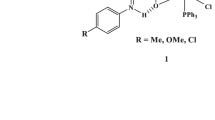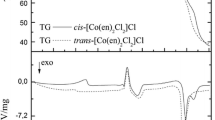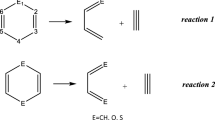Abstract
In search of the most thermally stable 1,1,1-trinitrocompounds, several well-known and new energetic 1,2,4,5-tetrazines have been synthesized. The thermal stability of obtained compounds has been investigated by the methods of isothermal and non-isothermal kinetics. The introduction of the OCH2 or NHCH2 bridge between the heterocycle and the trinitromethyl moiety has been confirmed to result in a significant increase in thermal stability. An increase in stability is accompanied by a decrease in the C–NO2 bond length by 0.025–0.029 Å. An additional increase in the thermal stability of 1.1,1-trinitro derivatives is possible due to the creation of high-melting compounds, the decomposition of which proceeds before melting. Trinitroethylamine derivatives are most preferred due to the strong hydrogen bonds of the NH group. However, in some cases, the actual stability of a substance is reduced by the appearance of autocatalysis. On the basis of experimental data of manometry, analysis of condensed decomposition products by HPLC and IR spectroscopy, a mechanism for the decomposition of 1,1,1-trinitrocompounds was proposed. The compounds studied were found to have favorable detonation properties, which were close to those of RDX, a commonly used explosive. At the same time, some of the obtained polynitro compounds have increased burning rates in comparison with the known nitramines HMX and RDX.
Graphical abstract




















Similar content being viewed by others
References
Pagoria PF, Lee GS, Mitchell AR, Schmidt RD. A review of energetic materials synthesis. Thermochim Acta. 2002;384(1–2):187–204. https://doi.org/10.1016/S0040-6031(01)00805-X.
Chavez DE, Parrish DA, Mitchell L. Energetic trinitro- and fluorodinitroethyl ethers of 1,2,4,5-tetrazines. Angew Chem Int Ed Engl. 2016;55(30):8666–9. https://doi.org/10.1002/anie.201604115.
Tang Y, Kumar D, Shreeve JNM. Balancing excellent performance and high thermal stability in a dinitropyrazole fused 1,2,3,4-tetrazine. J Am Chem Soc. 2017;139(39):13684–7. https://doi.org/10.1021/jacs.7b08789.
Sinditskii VP, Egorshev VY, Rudakov GF, Filatov SA, Burzhava AV. High-nitrogen energetic materials of 1,2,4,5-tetrazine family: thermal and combustion behaviors. In: DeLuca L, Shimada T, Sinditskii VP, Calabro M, editors. Chemical rocket propulsion. Springer: Cham; 2017. p. 89–125. https://doi.org/10.1007/978-3-319-27748-6_3.
Gao H, Zhang Q, Shreeve JNM. Fused heterocycle-based energetic materials (2012–2019). J Mater Chem A. 2020;8(8):4193–216. https://doi.org/10.1039/C9TA12704F.
Fershtat LL. Recent advances in the synthesis and performance of 1,2,4,5-tetrazine-based energetic materials. FirePhysChem. 2023;3(1):78–87. https://doi.org/10.1016/j.fpc.2022.09.005.
Sinditskii VP, Burzhava AV, Usuntsinova AV, Egorshev VY, Palysaeva NV, Suponitsky KY, Ananiev IV, Sheremetev AB. Increasing the burning rate through energetic compound tuning: hybrids of the furazan and [1,2,4] triazolo [4,3-b][1,2,4,5]tetrazine ring systems. Combust Flame. 2020;213:343–56. https://doi.org/10.1016/j.combustflame.2019.12.006.
Zhou J, Zhang J, Wang B, Qiu L, Xu R, Sheremetev AB. Recent synthetic efforts towards high energy density materials: How to design high-performance energetic structures? FirePhysChem. 2022;2(2):83–139. https://doi.org/10.1016/j.fpc.2021.09.005.
Kettner MA, Klapötke TM. Synthesis of new oxidizers for potential use in chemical rocket propulsion. In: DeLuca L, Shimada T, Sinditskii VP, Calabro M, editors. Chemical rocket propulsion. Springer: Cham; 2017. p. 63–88. https://doi.org/10.1007/978-3-319-27748-6_2.
Manelis GB, Nazin GM, Rubtsov YI, Strunin VA. Thermal decomposition and combustion of explosives and propellants. London: Taylor & Francis; 2003.
Nedel’ko VV, Zakharov VV, Korsounskii BL, Larikova TS, Chukanov NV, Shastin AV. Thermal decomposition of 2,4-diazido-6-trinitromethyl-1,3,5-triazine, 2,4-dimethoxy-6-trinitromethyl-1,3,5-triazine, and 2,4-diazido-6-methoxy-1,3,5-triazine. Russ J Phys Chem B. 2015;9(6):885–9. https://doi.org/10.1134/S1990793115060172.
Yu Q, Yin P, Zhang J, He C, Imler GH, Parrish DA, Shreeve JM. Pushing the limits of oxygen balance in 1,3,4-oxadiazoles. J Am Chem Soc. 2017;139:8816–9. https://doi.org/10.1021/jacs.7b05158.
Chen P, Dou H, He C, Pang S. Boosting the energetic performance of trinitromethyl-1,2,4-oxadiazole moiety by increasing nitrogen-oxygen in the bridge. Int J Mol Sci. 2022;23(17):10002. https://doi.org/10.3390/ijms231710002.
Chinnam AK, Staples RJ, Shreeve JM. 1,2-Bis(5-(trinitromethyl)-1,2,4-oxadiazol-3-yl)diazene: a water stable, high-performing green oxidizer. Dalton Trans. 2021;50:16929–32. https://doi.org/10.1039/D1DT03496K.
Sheremetev AB, Korolev VL, Potemkin AA, Aleksandrova NS, Palysaeva NV, Hoang TH, Sinditskii VP, Suponitsky KY. Oxygen-rich 1,2,4-triazolo[3,4-d]-1,2,4-triazolo[3,4-f]furazano[3,4-b]pyrazines as energetic materials. Asian J Org Chem. 2016;5:1388–97. https://doi.org/10.1002/ajoc.201600386.
Thottempudi V, Gao H, Shreeve JM. Trinitromethyl-substituted 5-nitro- or 3-azo-1,2,4-triazoles: synthesis, characterization, and energetic properties. J Am Chem Soc. 2011;133:6464–71. https://doi.org/10.1021/ja2013455.
Serushkin VV, Sinditskii VP, Hoang TH, Filatov SA, Shipulina AS, Dalinger IL, Shakhnes AK, Sheremetev AB. Thermal and combustion behavior of novel oxygen-rich energetic pyrazoles. J Therm Anal Calorim. 2018;132(1):127–42. https://doi.org/10.1007/s10973-017-6911-2.
Chavez DE, Parrish DA, Mitchell L. Energetic trinitro- and fluorodinitroethyl ethers of 1,2,4,5-tetrazines. Angew Chem Int Ed. 2016;55(30):8666–9. https://doi.org/10.1002/anie.201604115.
Rudakov GF, Kalinichenko AI, Nguyen TQ, Zinchenko SS, Cherkaev GV, Fedyanin IV, Sinditskii VP. Monosubstituted polynitroalkoxy-1,2,4,5-tetrazines: a new family of melt-castable energetic materials. Propellants Explos Pyrotech. 2021;47(3): e202100262. https://doi.org/10.1002/prep.202100262.
Su T, Guo T, Cai C. The synthesis and properties of 3,3′-bis (trinitroethylamino)-4,4′-bisfurazan (BTNEABF): a potential energetic material. J Energy Mater. 2020;38(4):386–94. https://doi.org/10.1080/07370652.2019.1702740.
Göbel M, Klapötke TM. Development and testing of energetic materials: the concept of high densities based on the trinitroethyl functionality. Adv Funct Mater. 2009;19(3):347–65. https://doi.org/10.1002/adfm.200801389.
Rudakov GF, Sinditskii VP, Andreeva IA, Botnikova AI, Veselkina PR, Kostanyan SK, Yudin NV, Serushkin VV, Cherkaev GV, Dorofeeva OV. Energetic compounds based on a new fused bis [1,2,4]triazolo[1,5-b;5′,1′-f]-1,2,4,5-tetrazine. J Chem Eng. 2022;450(Part 3):138073. https://doi.org/10.1016/j.cej.2022.138073.
Chavez DE, Hiskey MA. 1,2,4,5-Tetrazine based energetic materials. J Energetic Mater. 1999;17(4):357–77. https://doi.org/10.1080/07370659908201796.
Feuer H, Kucera TJ. Preparation of 2,2,2-trinitroethanol. J Org Chem. 1960;25(11):2069–70. https://doi.org/10.1021/jo01081a629.
Klapötke TM, Krumm B, Moll R. Polynitroethyl- and fluorodinitroethyl substituted boron esters. Chem Eur J. 2013;19(36):12113–23.
Kissinger HE. Reaction kinetics in differential thermal analysis. Anal Chem. 1957;29(11):1702–6. https://doi.org/10.1021/ac60131a045.
Rezchikova KI, Solkan VN, Kuznetsov SL. Quantum-chemical calculations by the MNDO method of the pre-exponential factor for the homolytic decomposition of aliphatic nitro and α-fluoronitro compounds in the gas phase. Bull Acad Sci USSR Div Chem Sci. 1990;39:283–6. https://doi.org/10.1007/BF00960653.
Sinditskii VP, Smirnova AD, Vu TQ, Filatov SA, Serushkin VV, Rudakov GF. Thermal decomposition of 1,3,5,5-tetranitrohexahydropyrimidine: a new type of autocatalysis that persists at high temperatures. Propellants Explos Pyrotech. 2021;46(1):150–8. https://doi.org/10.1002/prep.202000259.
Emanuel NM, Knorre DG. Course of chemical kinetics: textbook. 4th ed. Moscow: Higher School; 1984.
Korepin AG, Glushakova NM, Lempert DB, Kazakov AI, Shilov GV, Korchagin DV, Volokhov VM, Amosova ES, Aldoshin SM. 3,6-Bis (2,2,2-trinitroethylnitramino)-1,2,4,5-tetrazine. Structure and energy abilities as a component of solid composite propellants. Def Technol. 2022;18(7):1148–55. https://doi.org/10.1016/j.dt.2021.06.002.
Astakhov AM, Vasil’ev AD, Molokeev MS, Revenko VA, Stepanov RS. Nitroimines: II. Structure of nitroamino-1,2,4-triazoles. Russ J Org Chem. 2005;41:910–5. https://doi.org/10.1007/s11178-005-0265-0.
Korolev VL, Petukhova TV, Bakhmatova EA, Pivina TS, Sheremetev AB. Molecular modeling of the mechanisms of thermolysis of nitramino-1,2,4-triazoles. Chem Heterocycl Compd. 2006;42:1267–90. https://doi.org/10.1007/s10593-006-0236-6.
Li S, Zhang W, Wang Y, Zhao X, Zhang L, Pang S. 2,4,6-Tris(2,2,2-trinitroethylamino)-1,3,5-triazine: synthesis, characterization, and energetic properties. J Energy Mater. 2014;32:S33–40. https://doi.org/10.1080/07370652.2013.820232.
Recommendations on the Transport of Dangerous Goods, Manual of Tests and Criteria, 4 revised ed., United Nations, ST/SG/AC.10/11/Rev. 4, United Nations, New York and Geneva, 2003.
Sinditskii VP, Yudin NV, Fedorchenko SI, Egorshev VY, Kostin NA, Gezalyan LV, Zhang JG. Thermal decomposition behavior of CL-20 co-crystals. Thermochim Acta. 2020;691: 178703. https://doi.org/10.1016/j.tca.2020.178703.
Zhao L, Yin Y, Sui H, Yu Q, Sun S, Zhang H, Wang S, Chen L, Sun J. Kinetic model of thermal decomposition of CL-20/HMX co-crystal for thermal safety prediction. Thermochim Acta. 2019;674:44–51. https://doi.org/10.1016/j.tca.2019.02.001.
Dalinger IL, Vatsadze IA, Shkineva TK, Kormanov AV, Struchkova MI, Suponitsky KY, Bragin AA, Monogarov KA, Sinditskii VP, Sheremetev AB. Novel highly energetic pyrazoles: N-trinitromethyl-substituted nitropyrazoles. Chem Asian J. 2015;10(9):1987–96. https://doi.org/10.1002/asia.201500533.
Sinditskii VP, Egorshev VY, Berezin MV. Combustion of energetic cyclic nitramines. Zh Khim Fizika. 2003;22(4):53–60 (in Russian).
Stepanov RS, Kruglyakova LA, Astakhov AM. Effect of the structure of cyclic N-nitramines on the rate and mechanism of their thermolysis. Russ J Gen Chem. 2007;77:1293–9. https://doi.org/10.1134/S1070363207070237.
Nazin GM, Prokudin VG, Dubikhin VV, Aliev ZG, Zbarskii VL, Yudin NV, Shastin AV. Relation between the N–NO2 bond length and stability of the secondary nitramines. Russ J Gen Chem. 2013;83:1071–6. https://doi.org/10.1134/S107036321306011X.
Sinditskii VP, Smirnova AD, Serushkin VV, Aleksandrova NS, Sheremetev AB. Furazan-fused azacyclic nitramines: Influence of structural features on the combustion and the thermolysis. ChemistrySelect. 2020;5(44):13868–77. https://doi.org/10.1002/slct.202004081.
Li H, Zhang L, Petrutik N, Wang K, Ma Q, Shem-Tov D, Zhao FQ, Gozin M. Molecular and crystal features of thermostable energetic materials: guidelines for architecture of “bridged” compounds. ACS Cent Sci. 2019;6(1):54–75. https://doi.org/10.1021/acscentsci.9b01096.
Sun CH, Zhao XQ, Li YC, Pang SP. Synthesis of two new cage molecules containing trinitromethyl group. Chin Chem Lett. 2010;21(5):572–5. https://doi.org/10.1016/j.cclet.2009.12.001.
Lukyanov OA, Shlykova NI. N-(2,2,2-trinitroethyl)-N-polynitrohexaazaisowurtzitanes. Russ Chem Bull. 2016;65:748–50. https://doi.org/10.1007/s11172-016-1367-2.
Zhang Y, Li Y, Hu J, Xu C, Chen S, Ge Z, Sun C, Pang S. Energetic properties, thermal behavior and thermal safety of 4-(2,2,2-trinitroethyl)-2,6,8,10,12-pentanitro-2,4,6,8,10,12-hexaazaisowurtzitane. J Anal Appl Pyrolysis. 2020;152: 104924. https://doi.org/10.1016/j.jaap.2020.104924.
Keller A, Stark D, Fierz H, Heinzle E, Hungerbühler K. Estimation of the time to maximum rate using dynamic DSC experiments. J Loss Prev Process Ind. 1997;10(1):31–41. https://doi.org/10.1016/S0950-4230(96)00037-X.
Roduit B, Folly P, Sarbach A, et al. Estimation of time to maximum rate under adiabatic conditions (TMRad) using kinetic parameters derived from DSC-investigation of thermal behavior of 3-methyl-4-nitrophenol. Chem Propel Polym Mater. 2011;1:84–93.
Westwell MS, Searle MS, Wales DJ, Williams DH. Empirical correlations between thermodynamic properties and intermolecular forces. J Am Chem Soc. 1995;117(18):5013–5. https://doi.org/10.1021/ja00123a001.
Suntsova MA, Dorofeeva OV. Prediction of enthalpies of sublimation of high-nitrogen energetic compounds: modified Politzer model. J Mol Graph Model. 2017;72:220–8. https://doi.org/10.1016/j.jmgm.2017.01.013.
Benson SW, Cruickshank FR, Golden DM, Haugen GR, O’Neal HE, Rodgers AS, Shaw R, Walsh R. Additivity rules for the estimation of thermochemical properties. Chem Rev. 1969;69:279–324. https://doi.org/10.1021/cr60259a002.
Holmes JL, Aubry C. Group additivity values for estimating the enthalpy of formation of organic compounds: an update and reappraisal. 2. C,H,N,O,S, and halogens. J Phys Chem A. 2012;116:7196–209. https://doi.org/10.1021/jp303780m.
Kondrikov BN, Sumin AI. Equation of state for gases at high pressure. Combust Expl Shock Waves. 1987;23(1):105–13. https://doi.org/10.1007/BF00755649.
Jafari M, Keshavarz MH, Motamedi MR, Hosseini SH. An improved correlation for reliable assessment of the detonation performance of non-ideal explosives containing metals and the other solid particulates. ZAAC. 2021;647(6):673–80. https://doi.org/10.1002/zaac.2020004.
Meyer R, Köhler J, Homburg A. Explosives. Hoboken: Wiley; 2016.
Sinditskii VP, Egorshev VY, Serushkin VV, Levshenkov AI, Berezin MV, Filatov SA. Combustion of energetic materials governed by reactions in the condensed phase. Int J Energy Mater Chem Propuls. 2010;9(2):147–92. https://doi.org/10.1615/IntJEnergeticMaterialsChemProp.v9.i2.30.
Sinditskii VP, Egorshev VY, Berezin MV, Serushkin VV. Mechanism of HMX combustion in a wide range of pressures. Combust Expl Shock Waves. 2009;45(4):461–77. https://doi.org/10.1007/s10573-009-0057-x.
Sinditskii VP, Egorshev VY, Serushkin VV, Levshenkov AI, Berezin MV, Filatov SA, Smirnov SP. Evaluation of decomposition kinetics of energetic materials in the combustion wave. Thermochim Acta. 2009;496(1–2):1–12. https://doi.org/10.1016/j.tca.2009.07.004.
Acknowledgements
This research was supported by the Ministry of Science and Higher Education of the Russian Federation (Agreement with Zelinsky Institute of Organic Chemistry RAS No. 075-15-2020-803). X-ray diffraction data were collected using the equipment of Center for molecular composition studies of INEOS RAS with the financial support from Ministry of Science and Higher Education of the Russian Federation (Contract/Agreement No. 075-03-2023-642).The authors would like to acknowledge to Mrs. N.N. Kondakova for the assistance with thermoanalytical experiments.
Author information
Authors and Affiliations
Contributions
GFR contributed to conceptualization, visualization, writing—original draft, writing—review and editing; VPS contributed to conceptualization, visualization, writing—original draft, writing—review and editing; VVS contributed to methodology, formal analysis; VYE contributed to methodology, formal analysis, writing—original draft; SSZ contributed to investigation; AIB contributed to investigation; AIK contributed to investigation; PRV contributed to investigation; and SAA contributed to investigation, visualization, formal analysis, writing—original draft.
Corresponding author
Ethics declarations
Conflict of interest
The authors declared that there is no conflict of interest.
Additional information
Publisher's Note
Springer Nature remains neutral with regard to jurisdictional claims in published maps and institutional affiliations.
Supplementary Information
Below is the link to the electronic supplementary material.
Rights and permissions
Springer Nature or its licensor (e.g. a society or other partner) holds exclusive rights to this article under a publishing agreement with the author(s) or other rightsholder(s); author self-archiving of the accepted manuscript version of this article is solely governed by the terms of such publishing agreement and applicable law.
About this article
Cite this article
Rudakov, G.F., Sinditskii, V.P., Serushkin, V.V. et al. In search of the most thermostable 1,1,1-trinitrocompounds: polynitroethyl-substituted sym-tetrazine and bistriazolotetrazine. J Therm Anal Calorim 149, 2119–2136 (2024). https://doi.org/10.1007/s10973-023-12795-w
Received:
Accepted:
Published:
Issue Date:
DOI: https://doi.org/10.1007/s10973-023-12795-w




